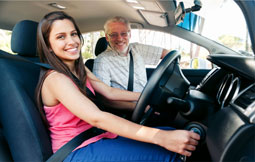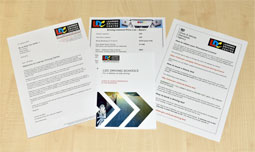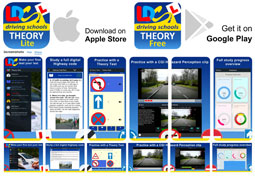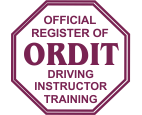Introduction
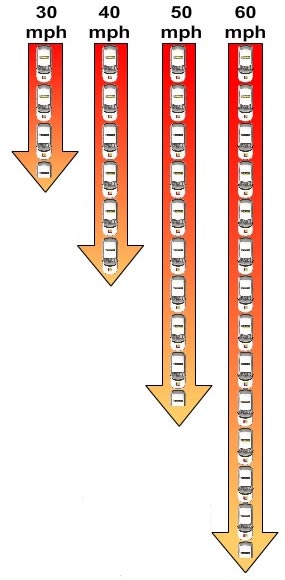 Hazard perception is all about giving yourself time to react so that you can take or plan appropriate defensive action well before any actual danger materialises.
Hazard perception is all about giving yourself time to react so that you can take or plan appropriate defensive action well before any actual danger materialises.
If you doubt the need to do this and you feel that it is sufficient to rely on your reactions alone think again. Even if you had lightening fast reactions you couldn't physically stop a car in fewer car lengths than those shown.
These distances assume you need no thinking time and can instantly apply the brakes as a child, or indeed other pedestrian, runs out in front of you. Note how the distance it takes for the car to stop grows disproportionately to the speed. Therefore even though you only double your speed from 30 MPH to 60 MPH your braking distance almost quadruples from 14 metres to 55 metres.
You could call this braking distance in front of you your impact zone. Anything that enters this zone will be hit. Indeed if you are travelling at 40 MPH or more you could call this area your killing zone because anyone that enters this area will most likely be killed. Very few people survive if a vehicle travelling at 40 MPH or more hits them.
This clearly demonstrates the importance of anticipating what might happen and acting upon that rather than waiting until it actually happens. As you will see good hazard perception combined with defensive driving will help to keep you and other road users safe.
What is a driving hazard?
A driving hazard may be defined as anything of actual or potential danger that may require you to change your vehicle's position, direction or speed. Basically hazards can be caused by static road features (e.g. junctions, bends, humps, dips, passing places, traffic lights, bridges, crossings, road works, parked vehicles, wet leaves, spilt oil, ice, snow, surface water etc) or by the actions of other road users or a combination of the two.
Although static road features can present a hazard the routine for dealing with them and the type of hazard they present is covered elsewhere in the Learner Driving programme. See LD System for more details.
In this section we will be concentrating on those hazards that develop through the actions of other road users and those circumstances that can contribute to their hazardous behaviour.
Static Hazard Examples
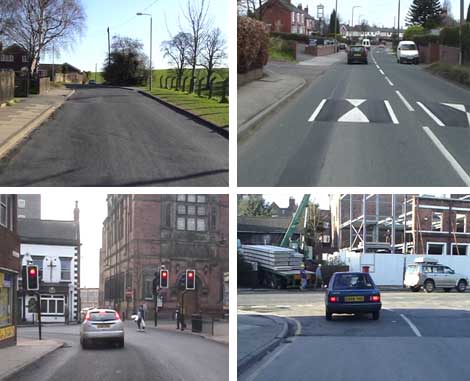
Moving Hazard Examples
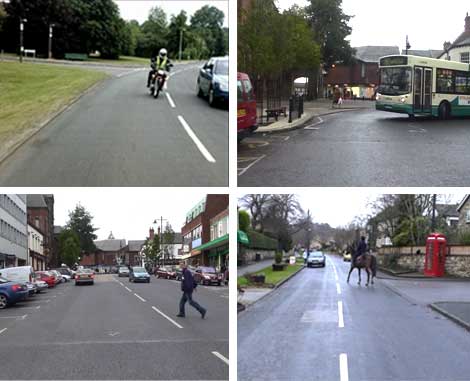
A bit of detection work
 Hazard perception in driving terms can be defined as: "The art of being able to pick out the important details from all the information provided by your senses." A perceptive driver must look for clues and build up a mental picture of what they think may happen next. To anticipate the actions of other road users and to determine any risks.
Hazard perception in driving terms can be defined as: "The art of being able to pick out the important details from all the information provided by your senses." A perceptive driver must look for clues and build up a mental picture of what they think may happen next. To anticipate the actions of other road users and to determine any risks.
Therefore hazard perception is the ability to recognise any actual or potential hazards as soon as it's possible to do so. Recognising the clues and knowing where to look to find them is how you can achieve this.
General clues
1. Road signs and road markings

Some clues help to prime your perception - to get you ready to look for a particular hazard ahead. Road signs and road markings are a very good example of this and yet few drivers learn to take note of them. Therefore to become a perceptive driver you must get into the habit of looking for road signs and markings.
Signs are designed to stand out. Signs that are designed to warn or advise you of a hazard ahead are usually triangular with a red border.
Signs that give you an order or let you know what is not permitted on a particular stretch of road are usually circular with a red border.
Blue circular or rectangular signs give you positive direction and indicate the flow or separation of traffic.
At road works yellow rectangular signs are used to direct traffic or impose any temporary restrictions.
Place name signs or direction signs are usually rectangular with arrows or a diagram of the road layout ahead.
There are also road signs that provide useful information, which may be used in conjunction with road markings.
Road markings can also warn you of a hazard ahead. For example the broken white centre line markings change on the approach to a hazard from this to this. Solid white lines along the centre of the road on your side also warn you of an approaching hazard and are there to inform you not to overtake.
It's imperative that you learn the meaning of all these road signs and markings and develop the habit of using them to help you consider what potential hazards may lay ahead.
2. The location, time of day and weather
The location, time of day and weather can also help to prime your perception of what potential dangers you may encounter.
Location
In a busy town or city centre it is unlikely that you will come across a wide agricultural vehicle, however, there may be one just around the corner on a narrow country road.
Time
Although children can be present on the road at any time, they are out in force just before and after school. At dusk and at night you lose the ability to see any detail and dark objects easily merge into the background. This particularly affects your ability to judge speed and recognise small poorly lit objects such as pedestrians and cyclists.
Meet situations that can be easily handled in daylight can become quite hazardous at night - particularly if there are no streetlights. Therefore at night expect drivers to make more errors of judgement.
Weather
Bright sunlight, fog, rain and snow can also severely affect visibility. Consider not only how this may affect you but also how these conditions may affect other drivers. Is the other driver being blinded by bright sunlight? Are the windows of other vehicles misty - can the driver see you?
When driving in strong wind, will the high-sided vehicle ahead remain stable as it crosses a gap in the hedge or buildings
Also consider the effects of water, ice and snow on the road surface; will this cause other drivers to skid, aquaplane or swerve?
3. The type of road users ahead
The type of road users ahead may also give you a clue of the potential dangers you may face.
Children, for example, have little time to consider road safety, they are far more interested in the game they are playing or the ice cream van they are running after. Look for clues. Are they alone? If one child runs or cycles into the road there will often be at least one more following; footballs are followed by children; cycles, seemingly abandoned at the side of the road, will mean that children are not far away.
Old people may not be able to see or hear very well or judge speed and distance, they will often need more time to cross the road. If an older person is driving their reactions may be slow and so they will take longer to deal with traffic situations.
Animals can also present a risk and may be easily frightened by the noise of traffic. Therefore, drive slowly, don't sound your horn or rev the engine and keep your distance. Watch their behaviour carefully, particularly if it is a horse being ridden by a child.
Cyclists can also present certain dangers as they may wobble and are particularly affected by uneven road surfaces. A High Court judge once ruled that a cyclist is entitled to wobble. "Drivers should have more control over their vehicles than cyclists who are dependent upon physical strength and effort to pilot their machines."
Therefore leave plenty of room when passing cyclists, look out for clues about their next move. For example, a cyclist who looks around over his or her right shoulder may be about to turn right; a puddle in the road will cause a cyclist to move out.
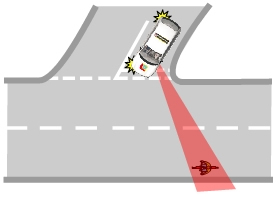 Cyclists are not easy to see and they can easily be hidden in the blind spots around your vehicle. Therefore always look around any pillars of the car that may be obscuring your view of the road before you emerge from a junction. Particularly watch out for cyclists in slow moving traffic they may overtake you on either side when you least expect.
Cyclists are not easy to see and they can easily be hidden in the blind spots around your vehicle. Therefore always look around any pillars of the car that may be obscuring your view of the road before you emerge from a junction. Particularly watch out for cyclists in slow moving traffic they may overtake you on either side when you least expect.
Motorcyclists like cyclists are not easy to see particularly at dusk and at night. Like cyclists they may also take up unusual road positions to avoid holes and bumps in the road surface. It is very easy to miss an approaching motorcyclist when emerging at junctions so remember think once, think twice, think bike!
Buses and other large vehicles need more room and may take up unusual road positions to turn round corners, emerge at junctions or turn into side roads.
Meet situations need special consideration when confronting large vehicles. Hold back and give them plenty of room.
Specific clues
Once you have primed your perception you are ready to scan the road for more specific clues that will alert you to any potential hazards ahead or indeed from behind. You should try to look as far ahead as possible for the early signs of such clues.
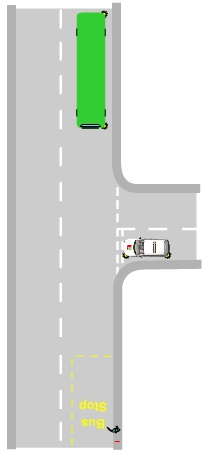 For example a driver who has just stopped may open his door without checking to see if it's safe; a driver who seems to be dithering about may be a stranger to the area and could, therefore, make a last minute turn without a signal when he sees the road that he is looking for. Sometimes the clues are not so obvious and you may need to assess a combination of factors to determine what a driver intends to do.
For example a driver who has just stopped may open his door without checking to see if it's safe; a driver who seems to be dithering about may be a stranger to the area and could, therefore, make a last minute turn without a signal when he sees the road that he is looking for. Sometimes the clues are not so obvious and you may need to assess a combination of factors to determine what a driver intends to do.
For example lets consider a bus that is signalling left just prior to the side road that you intend to emerge from. On the face of it the proposed actions of the bus driver may seem obvious he or she intends to turn left into the side road you intend to emerge from - therefore it's safe to go.
However, a perceptive driver would check all the other relevant information to make sure that it's consistent with the perceived action.
1. Is the position and speed of the signalling bus suitable to complete the proposed turn?
2. Is the driver looking in the direction they intend to turn?
3. And finally could the driver be signalling left for any other reason?
In this instance the bus driver was signalling left to pull up at a bus stop just after the side road.
Whenever you are considering the potential actions of other drivers make sure that everything is consistent with the action you expect and that no other action is likely before you decide. Train yourself to recognise inconsistency that's not quite right - why?
How to make it work in practice
In various studies it has been discovered that the eyes of expert drivers are constantly scanning around the field of view, no doubt seeking out visual clues that will help the driver predict future events.
The novice driver, on the other hand, tends to fixate on one object for some time then move to another. In the same distance travelled, where the novice may have had four or five eye fixations, the expert might have had twenty.
The other major fact that was discovered was that the expert driver was continually focusing up to five times further down the road than the novice. Clearly it was this behaviour that was giving the expert the edge over the novice when it came to driving safely.
1. See and be seen
To help you see any potential hazards ahead it's important to position your vehicle to give yourself the best possible view. Keep well back from the vehicle in front particularly if it's a large vehicle.
Provided it's safe and it will help to give you a better view of the road ahead move to the left or the right of your lane but avoid moving towards the centre of the road on bends.
2. Look well ahead for potential hazards
Watch for and take any opportunities to get a distant view of the road ahead - don't just concentrate on the view just beyond the end of your bonnet - make a conscious effort to look well down the road before you let your attention jump from one potential hazard to another.
When approaching bends look to see if there will be any opportunity to take a view across a bend so that you can see what's coming. A reflection in the window of any building on the bend may also help you to see what's around the corner.
3. Be selective in what you process, ignore superficial information
Train your mind to select only the relevant information you see. Ignore superficial information. For example don't concentrate on identifying individual drivers or pedestrians or the make, model and colour of vehicles. Instead concentrate on the position, speed and potential course of other vehicles and/or pedestrians both to the front, rear and sides of your vehicle.
4. Study the layout of the road, pinpoint potential hazards and minimise risk
A perceptive driver continually views the layout of the road ahead and pin points where the potential hazards are or where they might come from. At the same time he or she will assess how each potential hazard might affect his or her progress and what preparatory action can be taken to minimise the risk such as changing speed or position.
5. Prioritise the potential hazards and continually monitor developments
Some of the potential hazards will not materialise and can be quickly discounted whereas others might not. When considering where to focus most of your attention consider what is the probability of the hazard materialising and how much danger does it actually represent. Your eyes should be continually moving from one potential hazard to the next to see if there are any additional signs that it's starting to develop into an actual hazard.
Summary
Therefore to summarise, the skill of hazard perception requires you to:
Your hazard perception will improve with experience as you start to build up a memory of past hazardous behaviour to help you recognise the early signs of such behaviour in future.
You will, with experience, become more selective in what to focus your attention on and better able to interpret what you see. Initially you may perceive risks that aren't really there or indeed ignore risks that are. Guidance from your instructor will prove invaluable at developing this most important skill.
- Prime your perception by considering the type of hazards you might expect in this location, at this time of day and for the prevailing weather conditions;
- look well down the road along the course you intend to follow while scanning for any potential hazards;
- ignore superficial information, and do not let your mind wander or focus your attention on any particular object or event for too long;
- consider the physical layout of the road and determine where dangers may come from;
- watch out for vulnerable road users and those requiring special attention;
- assess the facts, put yourself in the shoes of other drivers and imagine what might happen next and finally;
- learn from your own mistakes and those of others.
Your hazard perception will improve with experience as you start to build up a memory of past hazardous behaviour to help you recognise the early signs of such behaviour in future.
You will, with experience, become more selective in what to focus your attention on and better able to interpret what you see. Initially you may perceive risks that aren't really there or indeed ignore risks that are. Guidance from your instructor will prove invaluable at developing this most important skill.

